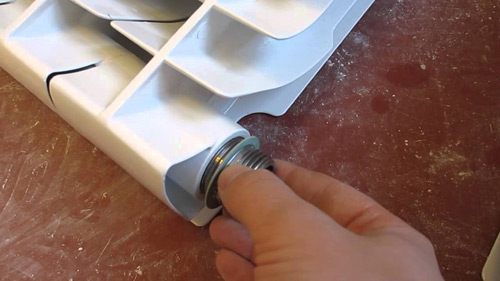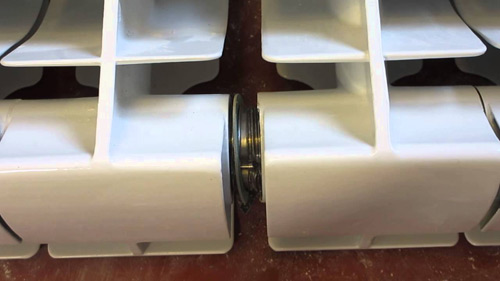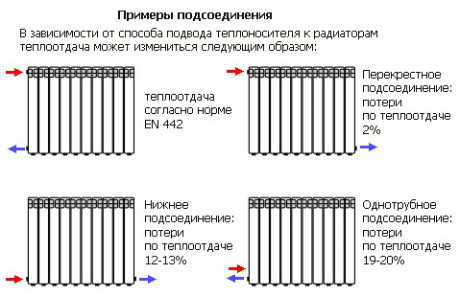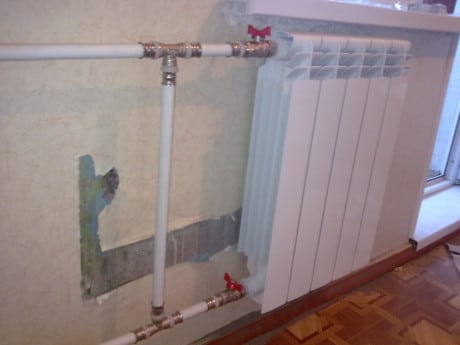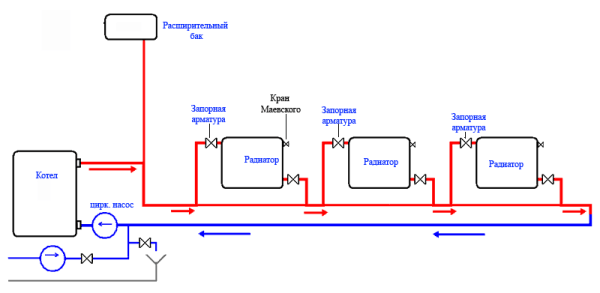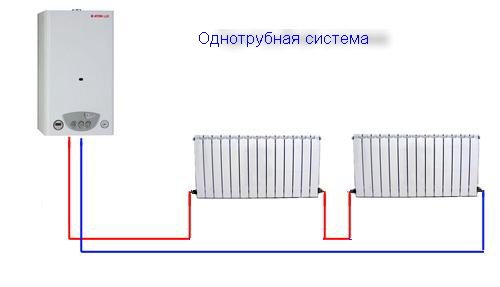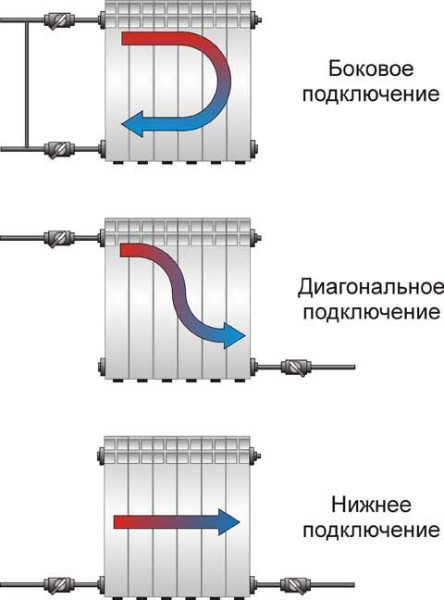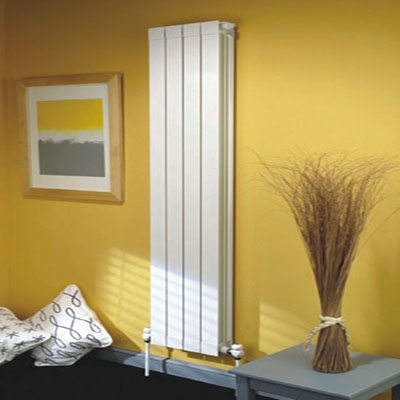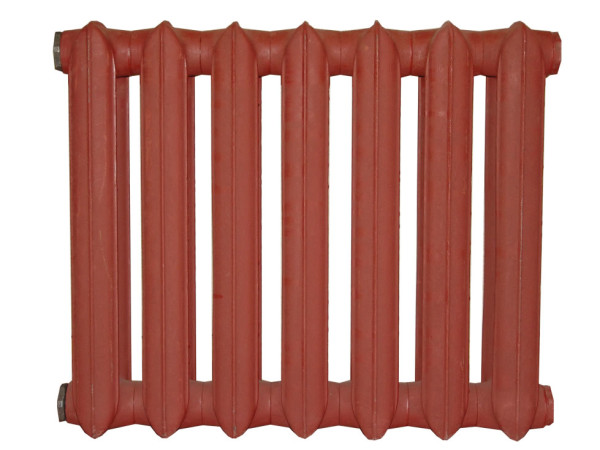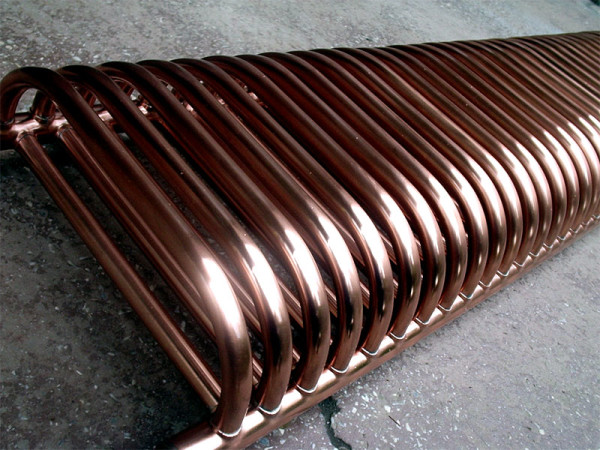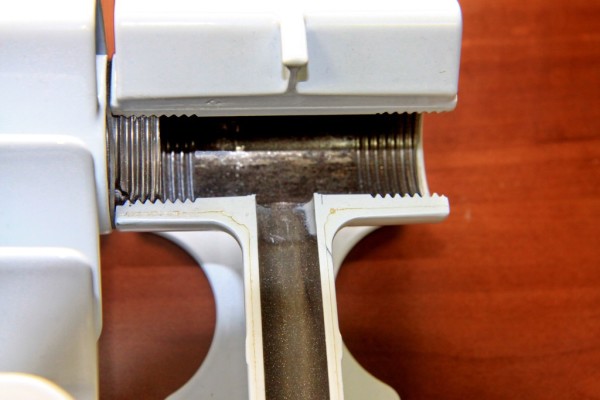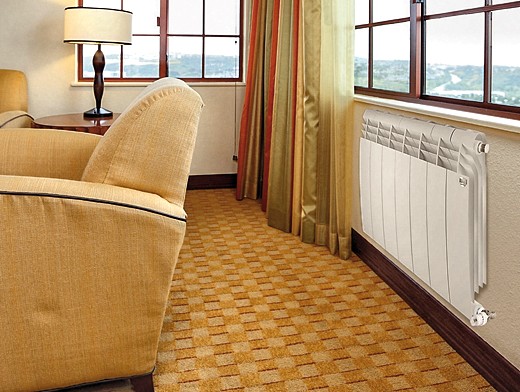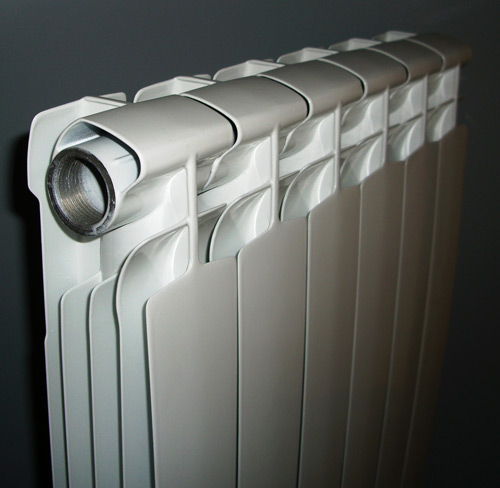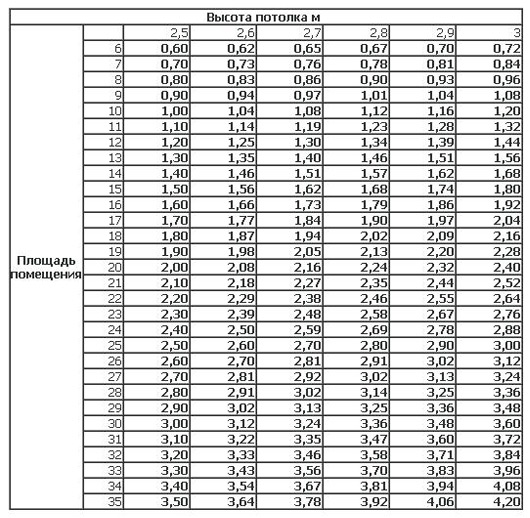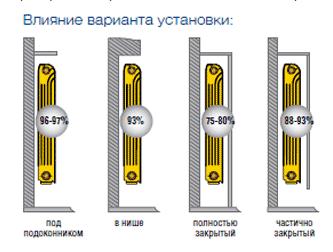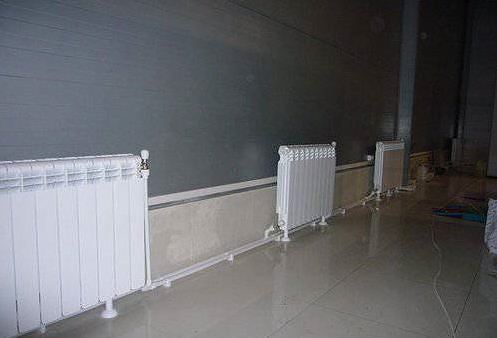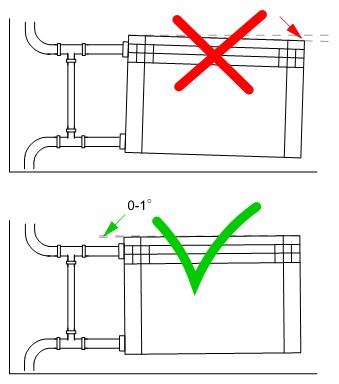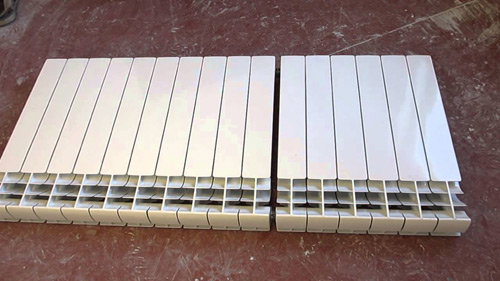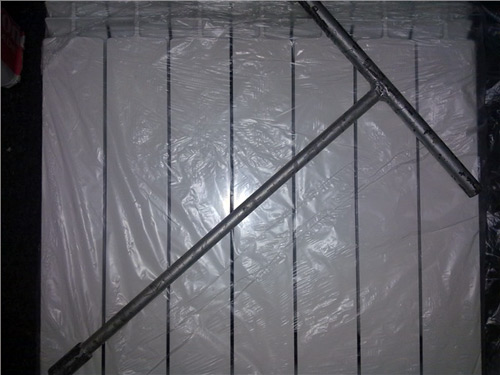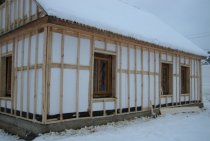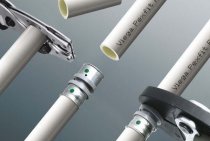How are sections added?
After you have empirically determined that the reason for the cool temperature in the house is not at all the clogging of the radiator, you should find a store near your home (so that you do not have to travel to distant lands and thereby waste your time) a store that sells heating equipment. You need to buy the same sections that your radiator is equipped with - cast iron, aluminum, or bimetallic.
It should not happen that you choose the wrong sections - because of such an error, you simply will not be able to add them, that is, the money spent will be thrown away, so be careful. The section extension procedure is carried out in the same sequence of actions for all types of heating radiators.
For docking sections, you need a connecting nut - nipple
We proceed directly to increasing the number of sections. The first step is to unscrew the futorka with a radiator key from the side to which you plan to add one or more elements. After you have untwisted the futorka, a nipple (connecting nut) is applied to the docking area of the sections. The following important feature must be taken into account: the threads at different ends of the nipple are different, and in order to properly install new sections, you must be guided by the following rules:
- The right side of the nipple should be directed to the side where the connection with the new element will be made;
- Accordingly, the left one - towards the already present sections of the heating radiator.
In order to prevent further battery leakage, intersectional gaskets should be put on the nipple (they can be rubber, paranitic, or gel)
At the same time, you need to put them on carefully and carefully - this will serve as a guarantee that the gasket will be located as evenly as possible, without unwanted distortions. Next, you need to tighten the thread
This action should also be carried out without sudden movements, in a leisurely rhythm, and carefully. If you want to qualitatively build up a heating radiator, then there can be no question of any rush.
An intersectional gasket is required to prevent leakage
It is highly undesirable to damage the metal thread - because of this, not the most harmless problems may appear, the solution of which will have to additionally spend your own time and financial resources.
The enlarged radiator must be placed back on the bracket and the connection to the central heating pipe must be renewed. To do this, you need to arm yourself with a wrench of the appropriate diameter and tow, which is necessary for wrapping pipe threads when screwing the radiator.
It is not difficult to add sections to a heating radiator, for this you do not need to work in a team of heating installers for 10 years. But without a serious approach, the availability of elementary tools and the removal of this process of your personal time is indispensable. However, you can also resort to the second option for solving the problem of insufficient heating of the premises - to become a client of a company providing such services, whose employees will do everything themselves, quickly and efficiently.
Installation of aluminum heating radiators
Assembling and adjusting the heating system is a responsible matter, it is best handled by professionals. But if you wish, you can install aluminum radiators with your own hands.
First you need to assemble the device:
- Screw in the included plugs and plugs.
- Assemble temperature controllers and attach shut-off valves at the inlet and outlet of the device.
- Check the nipples and fix the air valves.
The scheme of assembly-disassembly of the device is attached to the kit.It is better if the assembly is carried out by a specialist, then there will be a guarantee that all the taps are installed correctly. It is not allowed to clean aluminum with abrasives when installing adapters or building sections - a coolant leak may begin.
Attention! It is necessary to fasten the air valves so that at the end of the process their outlet heads look up. Having marked the installation location of the battery under the window in accordance with the indicated indents, brackets are attached to the wall
To do this, you need to drill holes with a puncher and insert plastic dowels, and screw the brackets into them. Screwing the fasteners, from time to time it is necessary to hang a radiator on them in order to maintain a distance of 5 cm from the wall
Having marked the installation location of the battery under the window in accordance with the indicated indents, brackets are attached to the wall. To do this, you need to drill holes with a puncher and insert plastic dowels, and screw the brackets into them. When screwing the fasteners, from time to time it is necessary to hang a radiator on them in order to maintain a distance of 5 cm from the wall.
Battery connection diagrams
The device can be connected in several ways:
Diagonal. Experts consider it the most energy efficient. The supply pipe is connected to the upper pipe, and the outlet pipe to the lower pipe, but on the opposite side of the radiator. With such a scheme, the battery gives off the maximum of thermal energy received from hot water into space. The disadvantage of the method is that the pipes running on top do not fit well into the design of the room.
Side. The pipe supplying the coolant is connected to the side fitting (right or left), the return pipe is connected to the parallel lower one. If the pipes are laid in the reverse order, the heat transfer of the device will drop by 50%. Such a scheme for connecting aluminum heating radiators does not work effectively if the sections are of a non-standard size, or their number exceeds 15.
In terms of design, bottom-mounted aluminum radiators win. With such a wiring, the pipes are not visible, they are hidden in the floor or in the wall. Batteries are connected to the system through pipes located at the bottom of the devices. Bottom-connected radiators are usually mounted on floor brackets. The battery is attached to the wall on one hook, only to maintain balance.
Connection diagrams for aluminum heating radiators
Important! Aluminum batteries have standard pipe parameters, so you don’t need to buy any additional adapters from the radiator to pipes. The device also comes with a Mayevsky crane, designed to bleed air
Connection and commissioning
Before installing aluminum appliances, the autonomous system is washed with water. Alkaline solutions should not be used.
Important! Aluminum is easy to wrinkle and scratch with tools, so it is better to mount the battery in the factory plastic packaging. After connection, the polyethylene can be removed
In an effort to connect aluminum heating radiators at a low cost, some homeowners use deaf, non-separable pipe and radiator mates. But heating a home in the northern hemisphere is not something to save on. It would be wiser to install “Americans” - quick-connect threaded assemblies, when the pipes are joined and disconnected using one union nut.
The procedure for connecting radiators to the heating system:
- Make sure that there is no water in the system or it is blocked at the installation points.
- Hang the radiator and connect it to the pipeline with the help of spurs.
- Seal all threaded connections using plumbing linen. Enough 4-5 turns in the direction of the thread.
- Pressurize the system.
Aluminum battery connected to the heating system
You can install an aluminum heating radiator yourself, but it would be wiser to entrust the matter to specialists who have all the necessary permits to perform such work.The slightest inaccuracy in installation can lead to leaks and inefficient functioning of the heating system.
Technique for performing work on connecting radiator sections

Building radiators is a useful skill for a home master. Knowing how to join the sections, it will not be difficult to provide your own microclimate in each room.
Before connecting two radiators, a power calculation is made. The formula is simple - 1 kW of thermal power is required per 10 m2. The performance of the section is indicated in the data sheet. These data will be useful for calculations. After you need to buy the required number of elements, find tools and assemble a heating device.
Tools and accessories for work

To assemble a heating radiator with your own hands, you will need:
- spanner or adjustable wrench;
- radiator key;
- plugs with right and left threads - 1 pc.;
- nipples;
- paronite gaskets;
- intersectional gaskets made of durable, flexible material;
- battery sections;
- sandpaper fraction No. 120.
Thread gloves are useful for protection. Batteries are more convenient to install together, the assistant will not hurt.
Step by step battery upgrade process
Do-it-yourself assembly of a heating radiator is carried out at any time. If the heating season has already begun, the network must be closed, the coolant must be drained from the circuit and the heater must be dismantled.
How to connect the battery:
- Lay the dismantled radiator on a horizontal plane. In order not to scratch the coating of the battery and the table (floor), lay a cloth. Remove all additional elements - taps, temperature sensors. To wash the battery, take it into the bath, open the plugs and rinse with a stream of water.
Check the integrity of the threaded connections, the ends of the heater. If there are build-ups of deposits, process the joints with emery.
Place the battery back on a flat horizontal surface. The site is selected even to ensure the tightness of the joint. The slightest curvature of the position will lead to an uneven joint.
For seals, only paronite gaskets are selected. It is a durable, flexible material that tolerates heat without loss of quality.
Check the thread quality of the nipples
Smooth and uniform cutting without chips is the key to a strong joint.
Move the sections by inserting spacers between them.
Carefully begin to twist the nipple. The part has a left-hand thread on one side and a right-hand thread on the other.
This means that both sections are attracted during rotation. It is more convenient to perform work with a special radiator key. The tool may come with a battery, but is also sold separately.

- Grab the sections a little, check the evenness of the joints and tighten until tight. The number of turns of the nipple turns on each section must be equal.
Knowing how to increase the heating battery, it is easy to assemble a system with the necessary power indicators. After building up the sections, the radiator is checked for leaks.
For a household check you will need:
- a piece of pipe with a cross section of 15 mm;
- automobile pump with a manometer;
- tire nipple.
Now solder the nipple to the pipe, and insert it into the radiator. This design is needed for air pressure testing. Install a plug on one of the radiator inlets. Connect a car pump with a pressure gauge to the nipple. Inject air at a pressure of 1 bar. If the tightness of the joints is broken, a whistle of the outgoing air will appear. It is necessary to find a leak, tighten the nipple or change the gasket. Carry out pressing again. If there are no leaks, install the radiator in the network.
Pressurization with water is carried out in the same order. Colored water is pumped in instead of air. Allow the device to stand for 5 hours, examine for leaks. If there is a leaky joint, water will seep through. Tighten the joints, check again, install the battery in the system.
The extended battery increases in weight.Before mounting the radiator, it is desirable to strengthen the fasteners, screw in additional brackets. This will protect the device from collapse, because with a coolant the battery will be even heavier. The device is built into the network in the selected location, taking into account the increase in the length of the battery.
Wiring diagrams
The most fault-tolerant scheme for connecting heating radiators in a private house with a bottling and a boiler is a single-pipe Leningrad. Heating devices are connected in parallel with the filling, which is laid along the perimeter of the room.
Somewhat cheaper to install, but noticeably more problematic to operate, a circuit using a series connection of batteries. Suffice it to say that their independent adjustment is impossible in this case.
A variant of a single-pipe circuit with a serial connection.
Finally, a two-pipe system involves connecting each radiator as a jumper between the supply and return threads. It is inconvenient in that it requires the already mentioned balancing - limiting the patency of heaters closest to the boiler.
What can be the schemes for connecting heating radiators to the supply?
- Unilateral. eyeliners are connected to the upper and lower radiator plugs on the right or left. It is compact, but makes the heating of the device uneven: the last sections will always be colder than the first.
- From down to down. In this case, the battery must be equipped with an air vent. The advantages of the solution are that the radiator with such a connection does not require flushing and always heats along the entire length.
- Diagonal. Heating of sections is even more uniform; however, the bottom corner of a blind plug fixture will gradually silt up.
Connection options for plumbing.
Bimetal heating radiators
Comparative characteristics with other types of batteries
In the photo - a tall narrow device.
First you need to understand what kind of heating radiators are, and how they differ from each other.
We list the main types:
- Cast iron batteries are one of the most common types found in most Soviet-era apartments. It is a system of connected cast-iron sections with sufficiently thick walls and a large mass. It is distinguished by high strength and durability, however, it has a low efficiency and heat transfer, and a large thermal inertia can also be noted;
- Steel tubular registers are a system of pipes of a sufficiently large diameter, or one pipe in the form of an S-shaped bend (an example is a heated towel rail). This type of device is usually installed in large rooms - concert halls, cinemas, sports complexes, supermarkets. They are distinguished by high power and large volume of coolant;
- Steel heating panels. They are welded profiled steel plates, inside of which there are channels for the circulation of the coolant. They have a rather low resistance to water hammer and low strength, are susceptible to corrosion and are not very reliable;
- Aluminum radiators are a more modern type of batteries, which are characterized by increased heat transfer and efficiency, a low volume of coolant and a low weight of the device. Due to the low thermal inertia, they lend themselves well to automatic and manual thermal control. Demanding on the quality of the coolant and its acidity, have an average strength and service life;
- Copper batteries - are a system of tubes with plate fins. They are distinguished by the highest heat transfer and efficiency, high strength and resistance to water hammer, no corrosion and long service life. The only drawback of copper units is the high price;
- Bimetallic radiators externally and in design resemble aluminum appliances with the difference that the inner walls of the channels are made of steel or copper. Thus, it is possible to increase the efficiency and heat transfer of the battery, but maintain its strength and durability.
Familiar to many cast-iron battery.
To understand the main distinguishing feature of a bimetallic device, you should better understand its design. The main task of any liquid-cooled battery is to ensure maximum heat transfer from the coolant to the environment, while having a sufficient margin of mechanical and corrosion resistance for long-term efficient operation.
The degree of heat transfer directly depends on the thermal conductivity of the metal and the wall thickness. The most heat-conducting materials are aluminum and copper, so the most efficient devices are made of non-ferrous metals.
The most efficient heatsinks are made of copper.
On the other hand, steel and ferrous metals demonstrate the highest strength. But they are susceptible to corrosion and have low thermal conductivity. At the same time, steel is much cheaper than copper and aluminum, which is also an advantage.
The design of a bimetallic radiator is different in that the inner walls of the channels are made of durable anti-corrosion steel or pure copper, and the outer walls and fins are made of light and heat-conducting aluminum. This solution made it possible to combine the advantages of steel and non-ferrous metals in one device.
The inner surface of the channels and the collector is made of steel.
Important! Bimetallic radiators combine the advantages of products made from ferrous and non-ferrous metals, becoming the most progressive and modern type of heating devices
Advantages and disadvantages
The convector fits perfectly into a modern interior.
Consider the positive and negative aspects of using aggregates with combined metals in the composition. Let's start with the benefits:
Radiator selection
You should start by choosing a radiator, and the main criterion for choosing will be the working pressure for which the radiator is designed. For a private house with its own heating system, a radiator with a working pressure of 6-7 atmospheres will be enough, but if you need to connect a radiator to the central heating system of an apartment building, it must withstand a pressure of at least 10 atmospheres.
Currently, the consumer is offered two options for aluminum radiators - standard or European and reinforced. The latter can operate under pressure up to 12 atmospheres. When connecting to a central heating system, it is necessary to choose among reinforced radiators.
The number of sections plays a big role
Next, you need to decide on the required number of sections. To do this, we determine the amount of heat. Necessary for heating the room and divide by the heat transfer of one section of the selected radiator.
The amount of heat required for a standard room can be taken equal to 1 kW per 10 m 2 of the room area. For non-standard premises and more accurate calculations, we will use the finished table:
Radiator power table
It should be remembered that a battery connection diagram of more than 12 sections must be double-sided, diagonal or saddle. With a one-sided battery connection scheme from a large number of sections, a "pocket" of cold water will form on the side of the radiator opposite to the pipes. "Extra" sections simply will not work, we get harmful ballast.
Using forced injection, the battery can be extended up to 24 sections even with one-sided supply, but in this case the radiator must be reinforced.
It should be remembered that it is necessary to supply the coolant to reinforced radiators under high pressure only through metal pipes. Metal-plastic can not withstand such pressure, and the consequences will be the saddest.
It should also be taken into account that the heat transfer of the radiator indicated in the documentation is relevant only for one-sided or diagonal supply of coolant to the radiator. When using the bottom feed, feel free to subtract 10-15 percent.
If the heating system is installed in a private house, then it is possible to choose the general scheme for organizing heating - one- or two-pipe.
Placement of heating devices
It is of great importance not only how to connect the heating radiators to each other, but also their correct location in relation to building structures. Traditionally, heating devices are installed along the walls of the premises and locally under the windows in order to reduce the penetration of cold air flows in the most vulnerable place.
There is a clear instruction for this in the SNiP for the installation of thermal equipment:
- The gap between the floor and the bottom of the battery should not be less than 120 mm. With a decrease in the distance from the device to the floor, the distribution of the heat flux will be uneven;
- The distance from the rear surface to the wall on which the radiator is attached must be from 30 to 50 mm, otherwise its heat transfer will be disturbed;
- The gap from the upper edge of the heater to the window sill is maintained within 100-120 mm (not less). Otherwise, the movement of thermal masses may be difficult, which will weaken the heating of the room.
Bimetal heating devices
To understand how to connect bimetallic radiators to each other, you need to know that almost all of them are suitable for any type of connection:
- They have four points of possible connection - two upper and two lower;
- Equipped with plugs and a Mayevsky tap, through which you can bleed the air collected in the heating system;
The diagonal connection is considered the most effective for bimetallic batteries, especially when it comes to a large number of sections in the device. Although very wide batteries, equipped with ten or more sections, are undesirable.
Advice! It is better to consider the question of how to properly connect two 7-8 section heating radiators instead of one device of 14 or 16 sections. It will be much easier to install and more convenient to maintain.
Another question - how to connect sections of a bimetallic radiator can arise when regrouping sections of a heater in various situations:
The place where you plan to install the heater is also important.
- In the process of creating new heating networks;
- If it is necessary to replace a failed radiator with a new one - bimetallic;
- In case of underheating, you can increase the battery by attaching additional sections.
aluminum batteries
Interesting! By and large, it should be noted that a diagonal connection is an excellent option for any type of battery. Do not know how to connect aluminum radiators to each other. connect diagonally, you can't go wrong!
For closed-type heating networks in private houses, it is advisable to install aluminum batteries, since it is easier to ensure proper water treatment before filling the system. And their cost is much lower than that of bimetallic devices.
Of course, over time, moving along the radiators, the coolant cools down.
Of course, you will have to try before you connect the sections of the aluminum radiator for rearrangement.
Advice! Do not rush to remove the factory packaging (film) from the installed heaters until the finishing work in the room is completed. This will protect the radiator coating from damage and contamination.
https://youtube.com/watch?v=y9a35JHa0TM
The work process itself does not take much time, you do not need any special skill or expensive equipment, you can purchase all the necessary tools at any hardware store. And do not forget, the connection will serve you for a long time and without hassle only if you used high-quality materials in your work and followed all the rules for installing the heating system.
We are talking about exactly what is shown in this picture.
In the presented video in this article you will find additional information on this topic.
Types of systems
- One-pipe system - one pipeline is mounted, through which the heat source is supplied and the exhaust fluid is drained. It is better to use in cases where a small number of batteries are installed. This is usually done when arranging the heating of apartments, where the riser passes in all rooms. With such a scheme, each next radiator will be colder than the previous one, but the number of pipes laid through the room decreases.
- The two-pipe system is the best device method, it makes it possible to maintain a uniform temperature of the heating fluid throughout the circuit. When mounting such systems, the supply line is usually located under the level of the window sill, and the return line is above the baseboard.
How best to connect heating radiators in one case or another, we will consider below, after we analyze each connection method separately.
- Lateral - with this method, the supply and reverse flow are supplied from one side. Works well with heating structures with up to 15 sections;
- Diagonal - best used on long heating elements. Communications are connected to the upper hole on one side and the diagonally opposite outlet.
- The lower one is the least efficient option, it requires high pressure in the coolant along the entire length of the heating structures. To maintain heat transfer, heaters with an increased number of sections are used. To ensure the normal temperature of private houses, it is used only if there is a pump of sufficient power in the heating system.
Test work
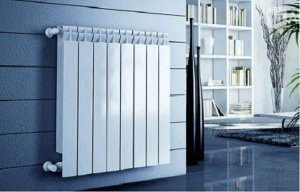
The initial check is carried out under a slight pressure to see if a leak appears somewhere. If a defect is found, the coolant is turned off, and work is carried out to eliminate it.
At the next attempt, water is supplied to the system under normal pressure and remains in it for a couple of hours. When they pass, you need to check all the joints for leaks.
Without special skills, sometimes it is difficult to dismantle and build up new sections correctly the first time, so the stage of checking the quality of the work done cannot be ignored. In general, if you have all the tools and follow the sequence of work, you can even connect two aluminum radiators together with your own hands.
Often, residents of houses and apartments are faced with one very serious problem - despite the systematic supply of a coolant of the required temperature, there is a lack of heat in the house, and staying in it causes some discomfort. To solve this problem, you will need to increase the heating radiator. What is this kind of work? The essence of this procedure is to add sections to the radiator, due to which a comfortable temperature in the home will be achieved.
Sections to the radiator are added if you need to heat a large room
First you will need to find a key for radiators, you must have it - if for some reason you cannot find it, then you need to borrow it from a friend or neighbor, or go to the store to buy a new one. So, with this key, you must remove the radiator, depriving it of connections to the heating system. Next, we take it to the bath and direct water into it.
Without a special key, adding sections will be unrealistic.
There are a large number of cases when the tenants of the apartment complained about the insufficiently comfortable air temperature in the dwelling, and the culprit was an elementary clogging of the radiator, which did not allow it to work "at full capacity". But if you sent water to the radiator, and it passes through its channels without obstacles and comes out clean, without having a cloudy appearance, then it's not a clogging of the heating device. Help in this case can only be provided by adding sections, in which, by and large, there is nothing complicated and difficult if you approach this task responsibly.
